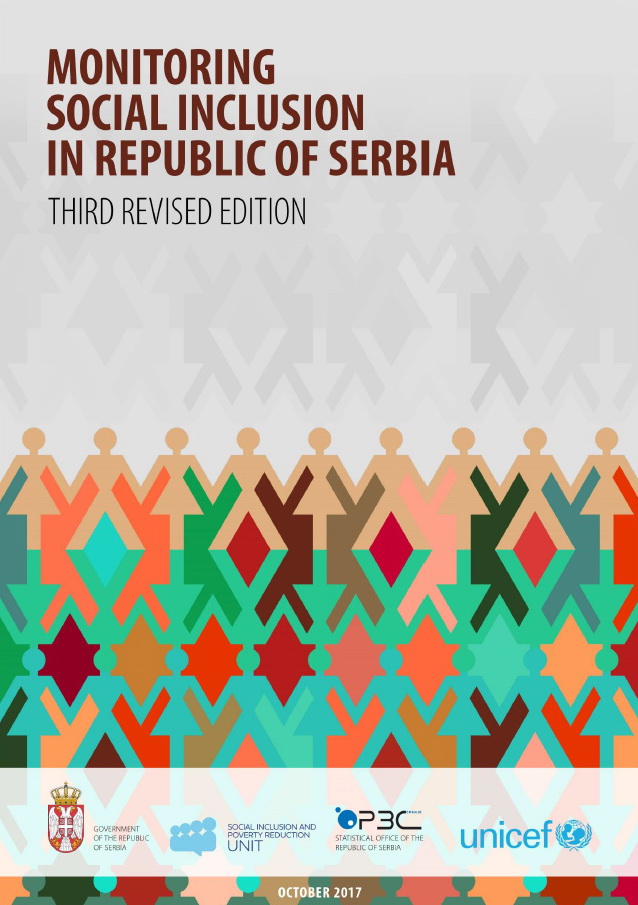 It is our pleasure to share with you the publication Monitoring Social Inclusion in the Republic of Serbia – third revised edition representing an improved framework for monitoring social inclusion and poverty reduction in the Republic of Serbia.
It is our pleasure to share with you the publication Monitoring Social Inclusion in the Republic of Serbia – third revised edition representing an improved framework for monitoring social inclusion and poverty reduction in the Republic of Serbia.
The publication is the product of the work of an expert team of the Social Inclusion and Poverty Reduction Unit of the Government of the Republic of Serbia and the UNICEF office in Serbia during 2016 and 2017. The Statistical Office of the Republic of Serbia provided professional support throughout the period of revision of the social inclusion indicators.
The indicators you have before you can be used in a number of strategic processes, primarily within the UN 2030 Agenda, as well as the Economic Reform Programme and Employment and Social Policy Reform Programme, as well as sectoral strategies and IPA fund programming.
The publication is organized so as to adhere to the nine domains of social inclusion (chapters V-XIV):
- Social protection and welfare – a broader set of indicators is available at the link
- Poverty, inequality, material deprivation – a broader set of indicators for poverty and inequality available at the link, a broader set of indicators of material deprivation available at the link
- Employment – a broader set of indicators is available at the link
- Education – a broader set of indicators is available at the link
- Healthcare – a broader set of indicators is available at the link
- Long-term care – a broader set of indicators is available at the link
- Pension system – a broader set of indicators is available at the link
- Social and child protection – a broader set of indicators is available at the link
- Quality of life – a broader set of indicators is available at the link
Contextual information providing a framework for observing individual domains and the baseline indicator of the Europe 2020 strategy (at-risk-of-poverty or social exclusion rate) have been covered in the two introductory chapters (chapters III and IV), while the thematic focus of the publication are children and investing into children (chapter XV).
The development of this publication is based on the preceding months-long expert work on thematic publications with a broader set of indicators in each of the above domains of importance for social inclusion.
The first steps towards defining social inclusion and poverty reduction indicators were made in 2009 (with the publication of “Monitoring Social Inclusion”), while the practice of reporting according to defined indicators started in 2010 and continued in 2012. The final goal of these activities is increasing social awareness on the scope of exclusion and creating adequate measures and policies aimed towards a more inclusive society.
Significant changes have occurred during the past seven years in domestic statistical practice, enabling, but also requiring improvements to the monitoring of social inclusion – the availability of the SILC survey, the availability of the ESSPROS database, the availability of the EQLS survey, surveys on the structure of earnings in 2014, Mapping Social Protection Services under the Competences of Local Self-Governments, etc. Additionally, the constant improvement of indicators at the EU level (primarily at the level of the Subgroup for the Development of Indicators of the Social Protection Committee) provides a solid basis for improving the monitoring at the national level.
Further improvements in monitoring the status of vulnerable social groups, as well as the population in general, will primarily require an increase in the availability of administrative data sources and their sorting (according to gender, age, ethnicity, disability), the networking of administrative and survey data, as well as an increase in the analytical capacities of employees in the institutions at the national and local level.
The challenges if future monitoring of the status of certain categories of the population will be additionally intensified through a number of social changes, particularly those brought about by “non-standard” forms of employment, as well as other global changes, such as migration.
The next steps in monitoring social inclusion and poverty reduction will cover activities on establishing periodic reporting, based on a narrower set of indicators that will enable faster assessments of changes in the social status of the population.
 Government of the Republic of Serbia
Government of the Republic of Serbia















 pdf [271 KB]
pdf [271 KB]
Leave a Comment